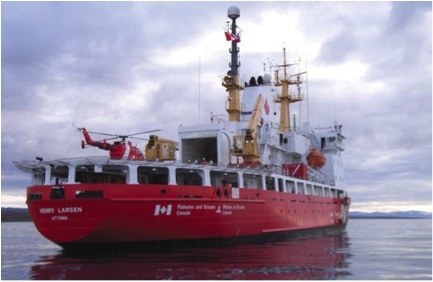
What’s Inside the Coast Guard’s Toolbox?
There are many sides to the Canadian Coast Guard. To start with, there is a fleet of approximately 118 vessels, a figure which includes not only ocean-going vessels ranging from icebreakers to SAR lifeboats, but also almost two dozen helicopters which are used on a daily basis for many services and operations — perhaps the best-known of which is airborne naval Search and Rescue. The aquatic tools of the trade used by the Coast Guard come in all shapes and sizes. At one end of the spectrum are vessels like the CCGS Louis S. St-Laurent, the 119 metre (393 foot) long heavy Arctic icebreaker which is widely viewed as the Canadian Coast Guard’s flagship vessel given its size, its large helicopter hangar and landing pad, its sophisticated science laboratories and its five powerful engines capable of churning out a total of close to 40,000 horsepower. At the other end of the size spectrum are the four dozen SAR lifeboats, the rugged 40 to 60 foot powerboats which are often the first responders to any distress call on Canada’s oceans or the Great Lakes. Given the extremely rough and treacherous seas on which they must operate while conducting rescue missions, each of the SAR lifeboats is specially designed to withstand the very worst that Mother Nature can come up with. Constructed in a manner that allows it to be what the naval industry refers to as a “self-righting” vessel, when a SAR lifeboat is hit by a wave strong enough to flip it upside down, the boat does not remain capsized. It rolls over until it is right side up again and is therefore able to continue carrying out its rescue operation despite the turbulent water.
Between the two size extremes can be found medium icebreakers, high endurance multi-task vessels, trawlers and an array of specialty vehicles ranging from oceanographic and other science-specific vessels to off-shore patrol vessels. However, one of the most unique pieces of equipment in the Coast Guard’s toolbox is neither a ship nor a boat — at least in the traditional sense — but rather a hovercraft.
The Coast Guard currently has four hovercrafts in its fleet, each of which is used daily in one capacity or another. Michel Vermette, Deputy Commissioner for Vessel Procurement in the Canadian Coast Guard said that the hovercrafts are anything but novelty vessels. They provide very real services. He explained that, although they sit upon an air-cushion instead of a heavy steel hull, “In the St. Lawrence River, or other regions that have thin ice, they are effectively used for breaking ice.” The hovercrafts serve as efficient and effective thin icebreakers by “riding on top of the ice and using the hovercraft’s sheer weight to cause the ice to collapse.” In fact, Vermette noted that their very shallow draft allows the hovercrafts to “do a lot of buoy maintenance due to the fact that they can get in and out of shallow areas easily.”

Time and tide wait for no one and the same can be said for machines. As Vermette says, “Many of our ships are over 30 years old.” While the Coast Guard may have taken delivery of new SAR lifeboats over the past decade and a half, the Deputy Commissioner is quick to point out that the larger vessels currently serving in the Canadian Coast Guard’s fleet are anything but new additions. As he puts it, “The reality is that we haven’t put into service a large vessel in more than a generation. The last new, purpose-built large vessel [that we acquired] was the CCGS Henry Larsen, which was brought into service in 1988.”
But the times are changing. Under the 2011 National Shipbuilding Procurement Strategy (NSPS) and with the 2012 Federal Budget, $5.2 billion will be allocated for the design and construction of new ships for the Canadian Coast Guard and the Royal Canadian Navy. Vancouver Shipyards Co. Ltd. has won the NSPS “Non-Combat” (Coast Guard) portion of the shipbuilding contracts, a contract that includes the construction of a new state-of-the-art heavy polar icebreaker named the CCGS John G. Diefenbaker to replace the aforementioned CCGS Louis S. St-Laurent, as well as one off-shore oceanographic science vessel and three offshore fisheries science vessels for the Coast Guard. John Shaw, Vice-President of Government Relations and Business Development at Seaspan Shipyards, the parent company to Vancouver Shipyards Co. Ltd. which is tasked with building the new Coast Guard vessels explains the process.
The first vessels to be built will be the three off-shore fisheries vessels. “We’re still going through the design process for those initial vessels” but once the design stage is complete, “We will approach the building process by staggering the start times for each vessel but, [as things get rolling,] we will actually build them simultaneously.” Getting to that stage isn’t easy. Shaw pointed out that “Building the first ship will be a little bit slower than the subsequent ships because we need to bring our new ship-building facilities up to speed to [facilitate] the construction [of all of the ships on order].” Yet, he was optimistic that “of course, once we have started production of any of these vessels, the timelines for construction will accelerate.”
Many of the Coast Guard’s nearly two dozen helicopters are not exactly spring chickens either. In fact, Canada operates the oldest fleet of MBB 105 light helicopters in the world. According to Deputy Commissioner Michel Vermette, the Coast Guard is in the process of “requesting to bid on replacing many [of our helicopters] with up to 24 new light and medium helicopters.” He noted that, in theory, replacing the Coast Guard’s helicopters with newer products is a less complicated task compared with constructing purpose-built ships which are designed and built from the ground up in specialized facilities. As Vermette puts it, “in this case we’re buying commercial off-the-shelf equipment.” It remains to be seen if that process will be as straightforward as it is hoped.
Here’s the Coast Guard at a glance.
The Coast Guard:
• Provides resources and support for maritime-based Search and Rescue (SAR) operations which results in some 2,000 lives being saved annually;
• Manages innumerable navigational aids which help vessels stay on course;
• Monitors naval traffic;
• Provides essential information to mariners;
• Conducts aquatic scientific research;
• Responds to naval-based environmental emergencies; and, of course,
• Provides ice-breaking services









